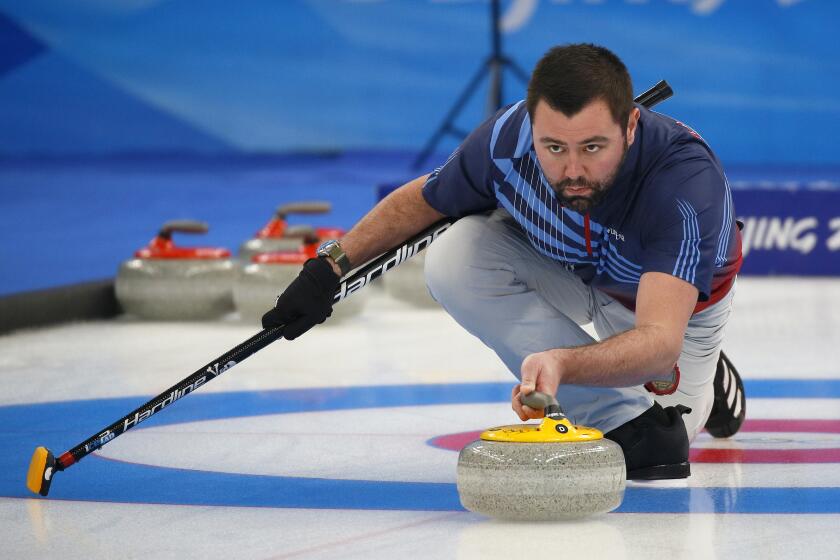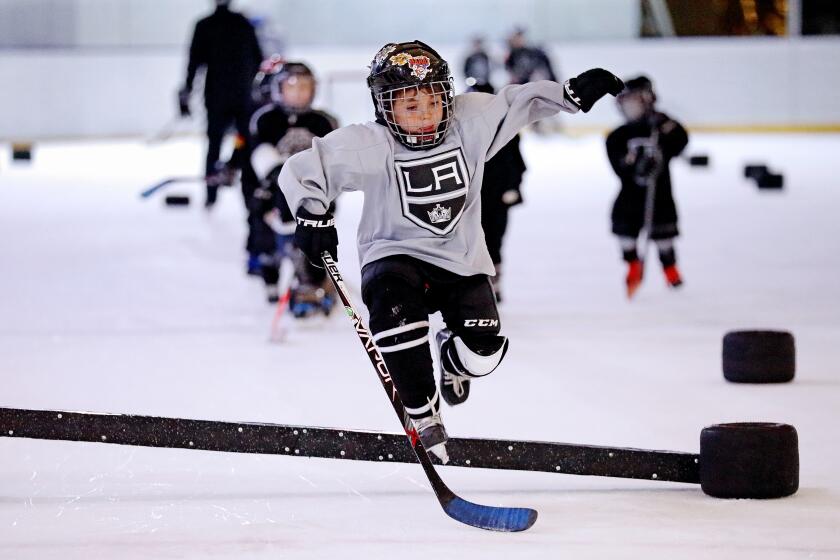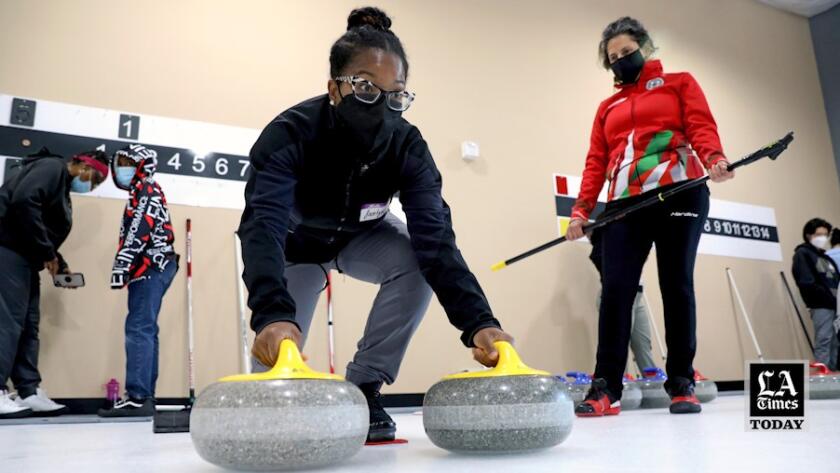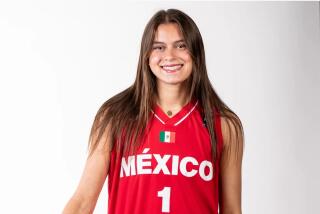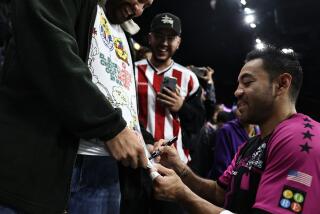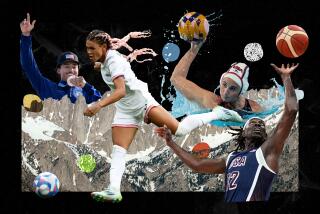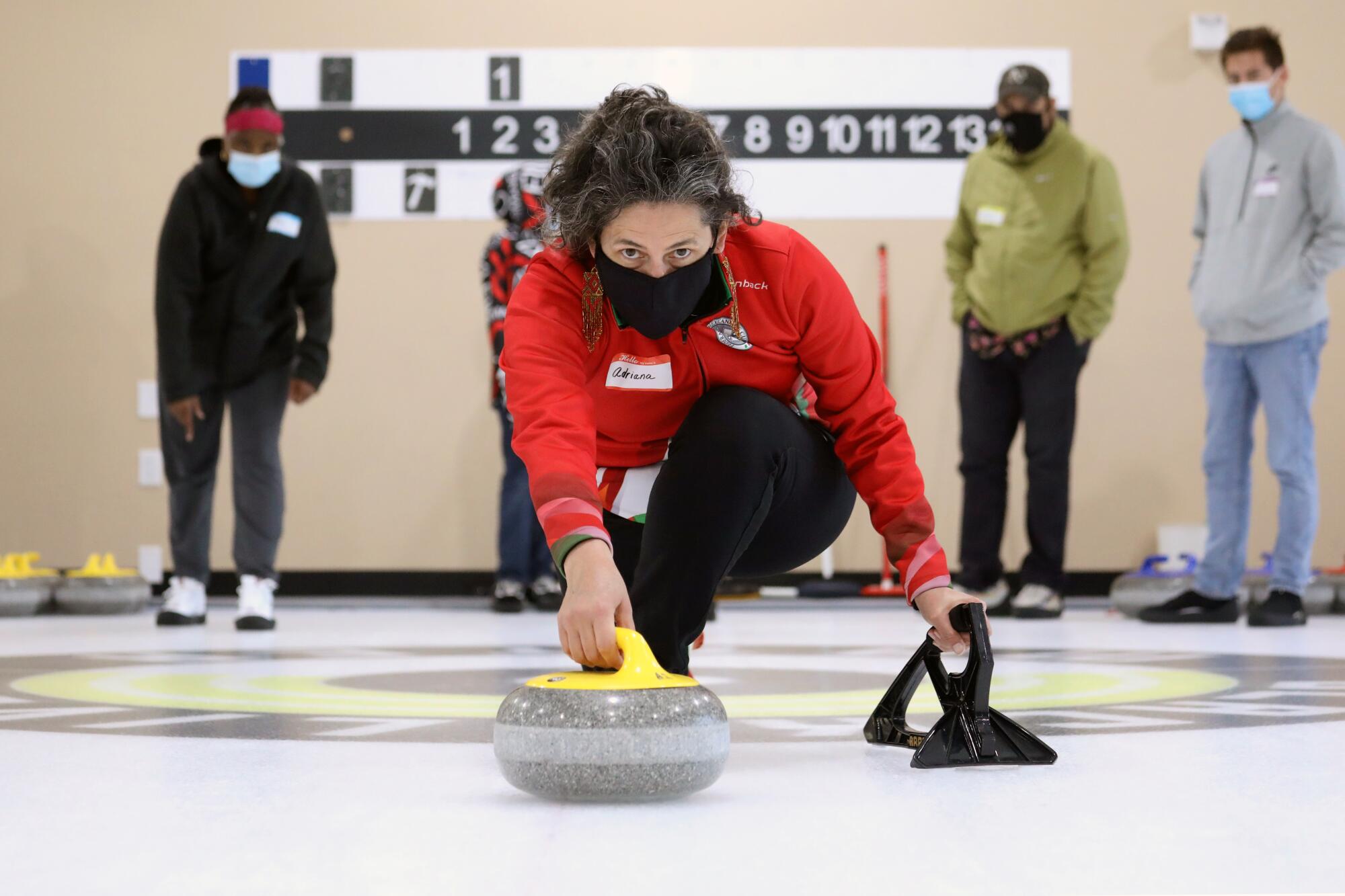
- Share via
OAKLAND — José Sepúlveda believes dreams don’t have to end when you wake up.
“My dream,” he said “was to be an Olympian. To compete for Puerto Rico.”
He tried fencing, then gymnastics. But he kept waking to the same reality.
“I was not good. I couldn’t make it,” he said. “But I still hold the dream of representing Puerto Rico.”
He eventually decided the problem wasn’t with the dream, it was with the sport. That’s when he discovered curling, the Winter Olympics competition that is part shuffleboard, part light housekeeping played on a sheet of ice.
“I was in a bar and I saw curling. I felt, ‘You know what? Maybe I can do this. Let me give it a try,’ ” remembered Sepúlveda, a 53-year-old audio-video engineer.
Curling becomes a popular sport every time the Winter Olympics come around, but the sport is more complicated to play than viewers might think.
“Maybe you believe that maybe I am too old for this. You know what? I can do this. No matter how old I am.”
He’s not the only one who feels that way. On many evenings at the San Francisco Bay Area Curling Club, the Oakland facility where Sepúlveda practices, he is surrounded by a half-dozen other young adult and middle-aged Walter Mittys; urban-studies professors, community activists, social media managers and public-school teachers, many of whom dream of representing their countries as curlers.
It’s a dream that appears more and more possible as new and emerging markets begin to embrace the sport, making its base both larger and more diverse.
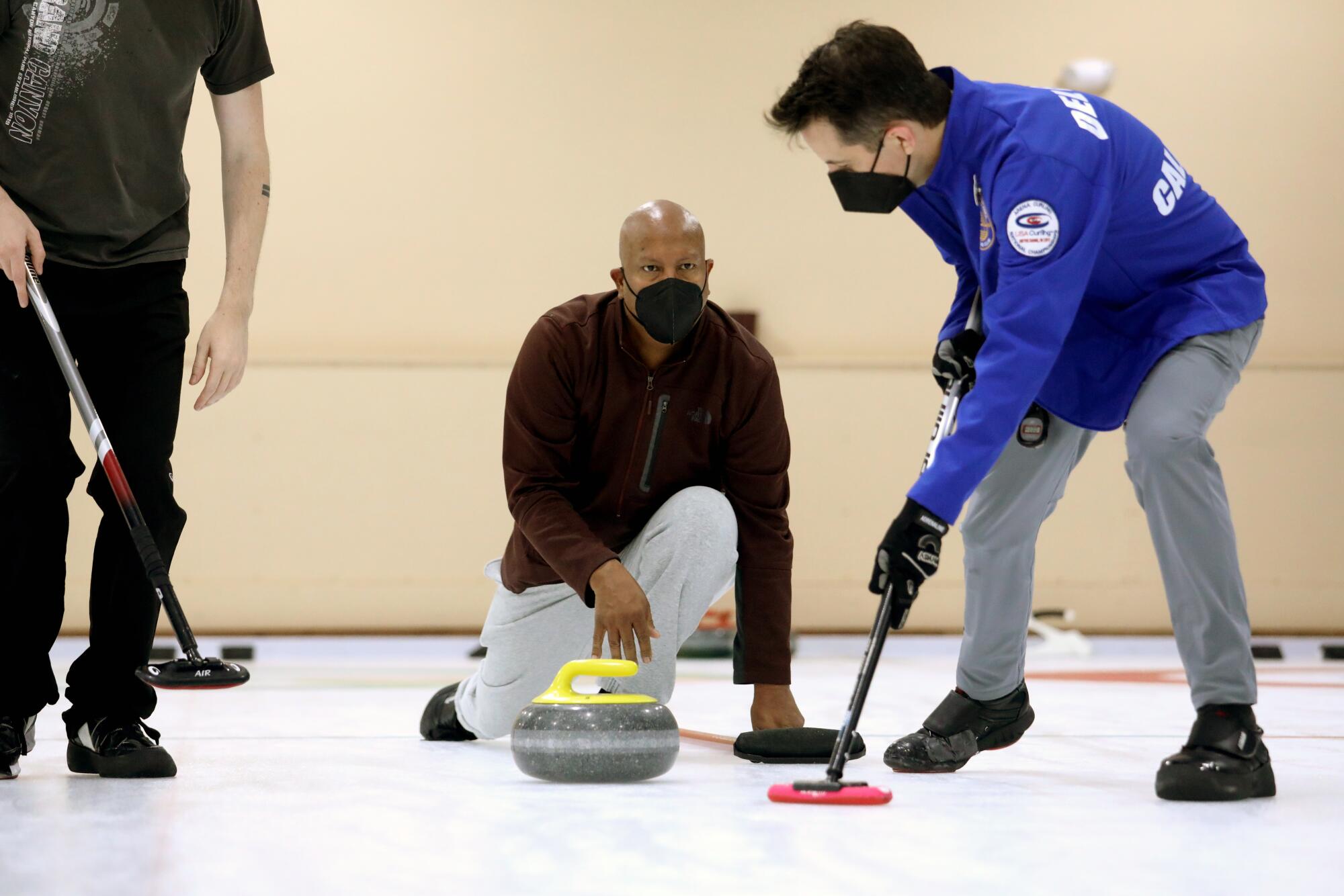
“The allure of being in a small program where there’s very few people, you’re thinking, ‘If I start playing and I want to play competitively, I’ve got a pretty good chance of getting good coaching and ending up as a part of the national squad,’ ” said Adriana Camarena, a Mexican-born writer and activist from San Francisco who joined Ramy Cohen to represent Mexico in the 2019 world mixed doubles championships, becoming the country’s first international curlers.
“I had been joking for many years that I was the Mexican curling team,” she said. “And suddenly I was.”
If Latin America had a patron saint of curling, it would be Camarena, whose temple is an abandoned construction-supply store in a gritty industrial neighborhood in the shadow of the former Oakland Coliseum.
“I love to be able to see a multitude of ethnicities, or backgrounds, sexes, everything. It didn’t matter what you were, if you love the sport, you wanted to curl, you just came out.”
— Kristina Lugo, a social media manager from Oakland
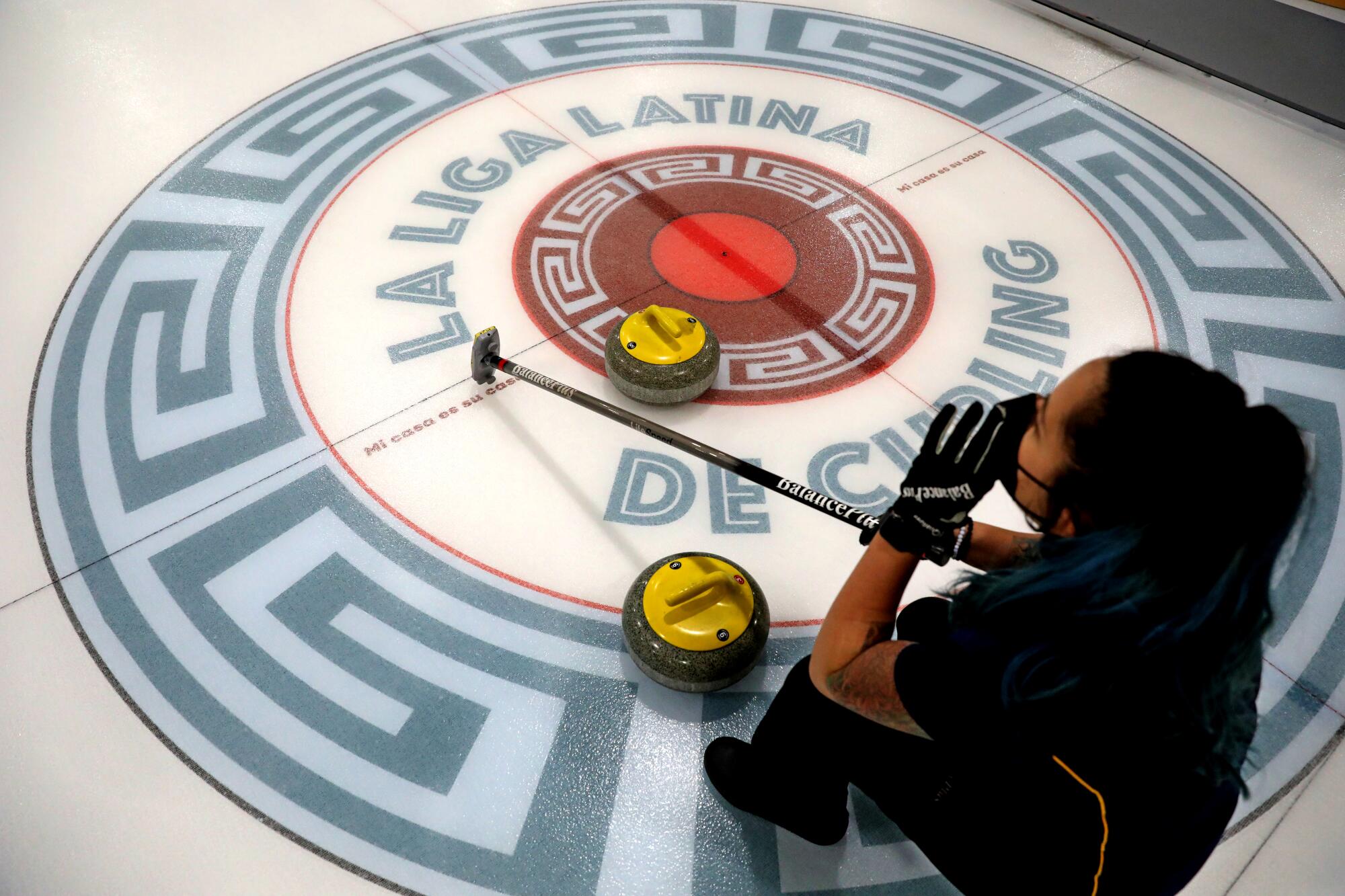
“We call it the curliseum,” Camarena said of the curling club’s six-month-old facility, which has five curling sheets.
Camarena, 51, took up the sport 11 years ago and has been consumed by it ever since, speaking of the sport with the passion and persuasion of a Southern preacher. And like a preacher, she believes in its ability to change hearts and minds.
“It could be that I don’t like to be tackled to the ground. But maybe I try curling once and it’s my thing, it’s my jam,” she said. “That’s the opportunity we want to provide.”
On a recent warm summer evening, Camarena took the ice in Oakland wearing a tri-color Mexican national team jacket, a black COVID-19 facemask and a red-and-white adhesive nametag. A diverse group of a couple dozen curious people — Black, brown, Asian and white — had come to the club to try their hand at curling. These moments, when she has the chance to win over eager new converts, are the ones Camarena lives for.
Donovan Carrillo, who is the best ice skater in Mexican history and trains at a shopping mall rink, is headed to Beijing. It’s taken lots of perseverance.
“I’ve taught varying ages, from ages like 7 to 10 to 12 to adults to grandmothers in their 60s, 70s,” she said. “And they could all play. I came to curling much as anybody comes to curling: You see the sport, you’re intrigued by it, you find a curling club and you’re immediately embraced.”
That the group mirrored the multicultural community outside the curliseum’s doors made it even better.
“Just look around,” she said. “See[ing] another Black curler, another Latina curler, another Asian American curler — just seeing somebody else at the club and knowing they’re there makes them more likely to belong. Beyond creating diversity, you aim to create a culture of belonging. And that involves actually developing cultural changes in curling.”
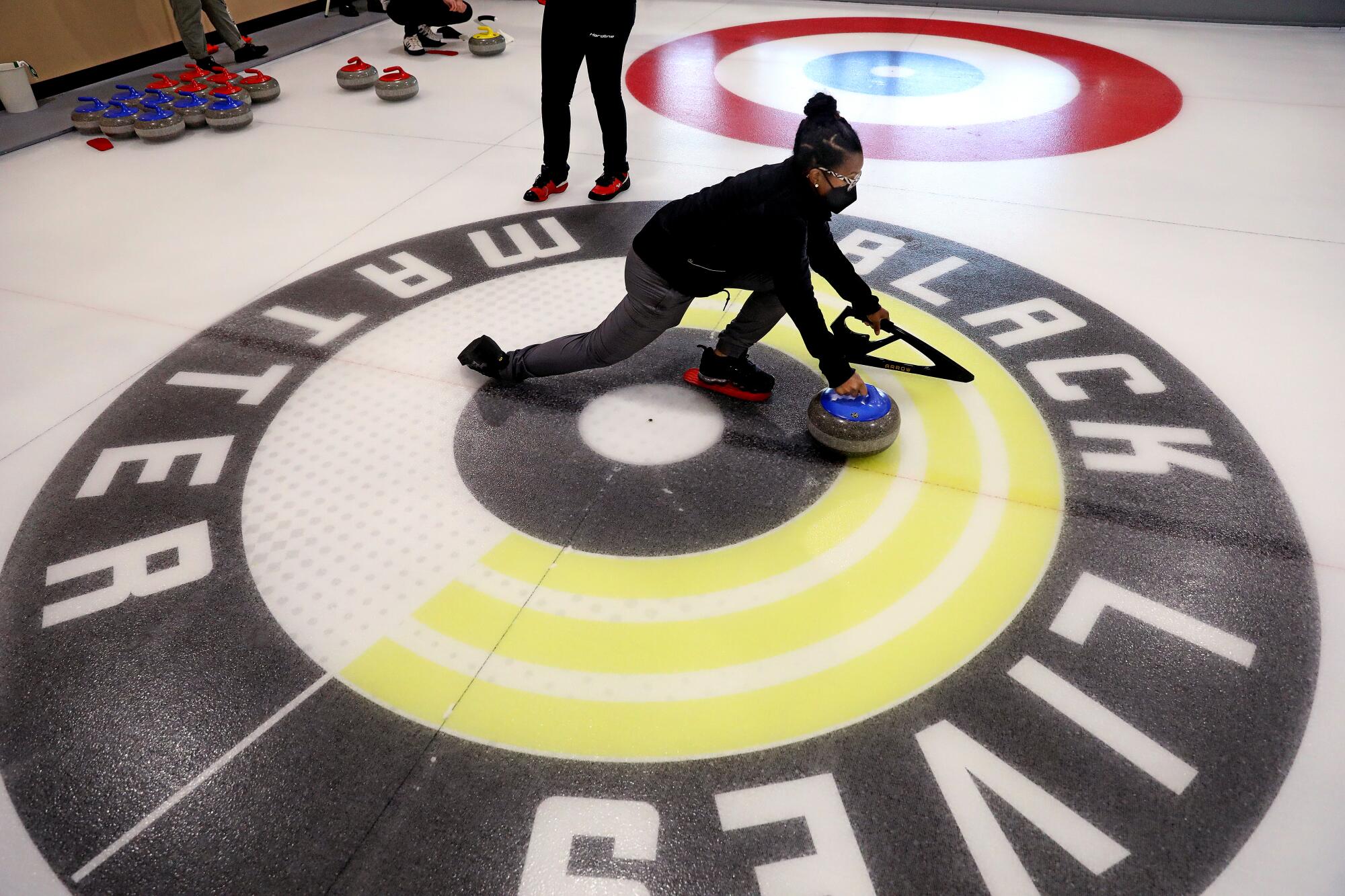
Tyler George agrees. A three-time U.S. champion and an Olympic gold medalist in 2018, George has taken a break from competition to become an ambassador for the sport, joining Camarena in proselytizing about curling to people who may have never heard of the sport.
“Inviting other communities and cultures in, we’re trying to put a face to it. Instead of saying we’re an inclusive sport, we’re trying to show up and actually say it to their faces,” he said.
The sport is perfect for that because, at its basic level, it doesn’t require unusual amounts of either speed or strength, size nor stamina. Instead, teams of two to four players take turns sliding polished granite stones, which weigh between 38 and 44 pounds, across a 146-foot sheet of ice toward a circular target or house, with points awarded for the stones that stop closest to the center of the target. As each stone is pushed toward the house, teammates aggressively sweep the ice ahead of it with a broom, allowing the rock to slide farther.
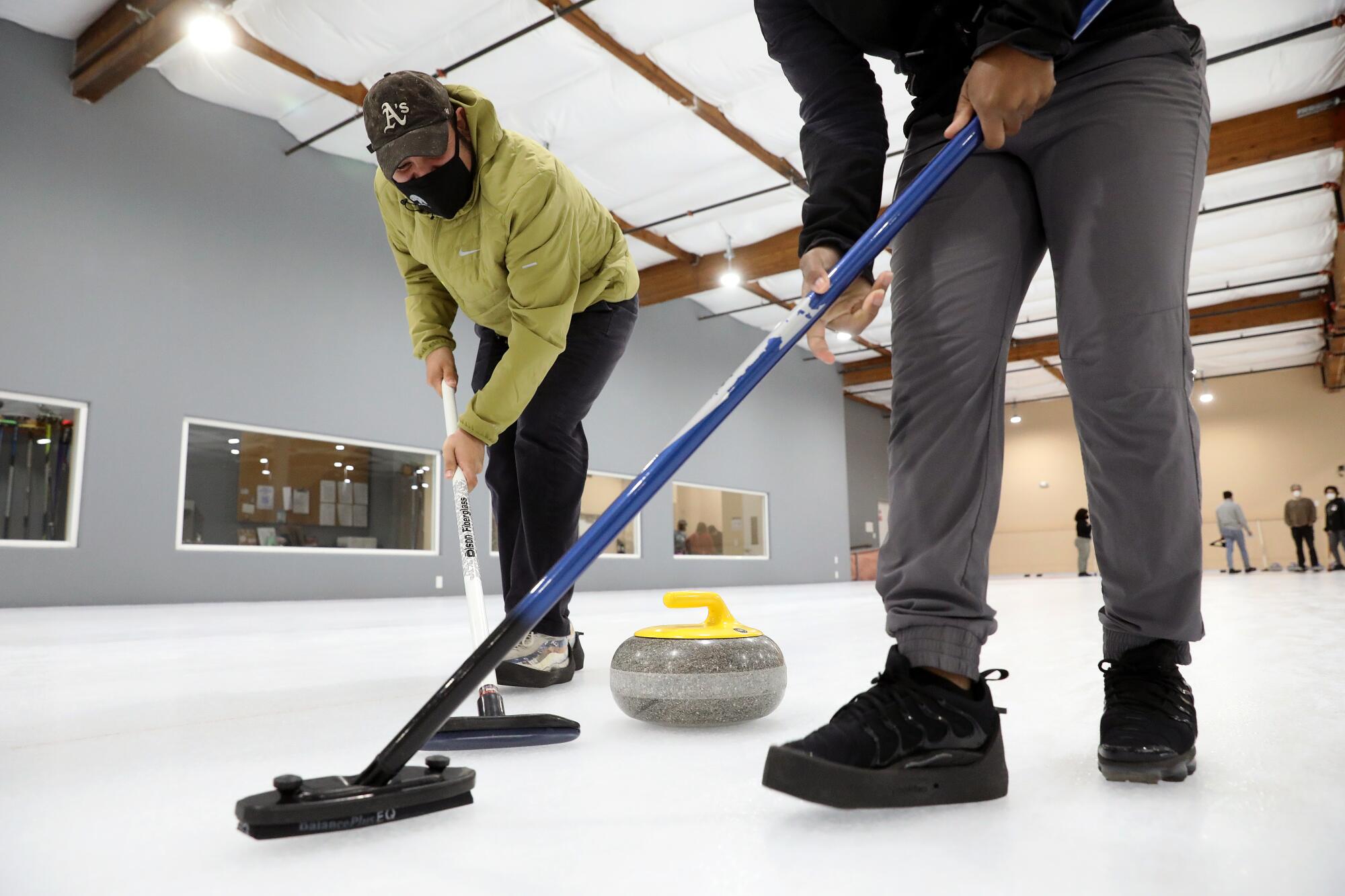
“There isn’t a particular skill set that you’d say, ‘Oh, that person because they can do this, they can be a curler.’ There’s not a specific type of person that curls,” George said.
“It’s a great sport to get involved in if you want a chance to represent your country because you’re not competing against thousands of others, like with baseball,” he added. “Even if you come in and you’re not trying to play at an Olympic level, it’s kind of like golf in that anybody can do the simple things.”
It’s that lack of a defined skill set, along with curling’s status as a cult pursuit, that has Sepúlveda believing he can be an Olympian at 53, and Camarena believing she can diversify a sport that has long been as white as the ice on which it’s played.
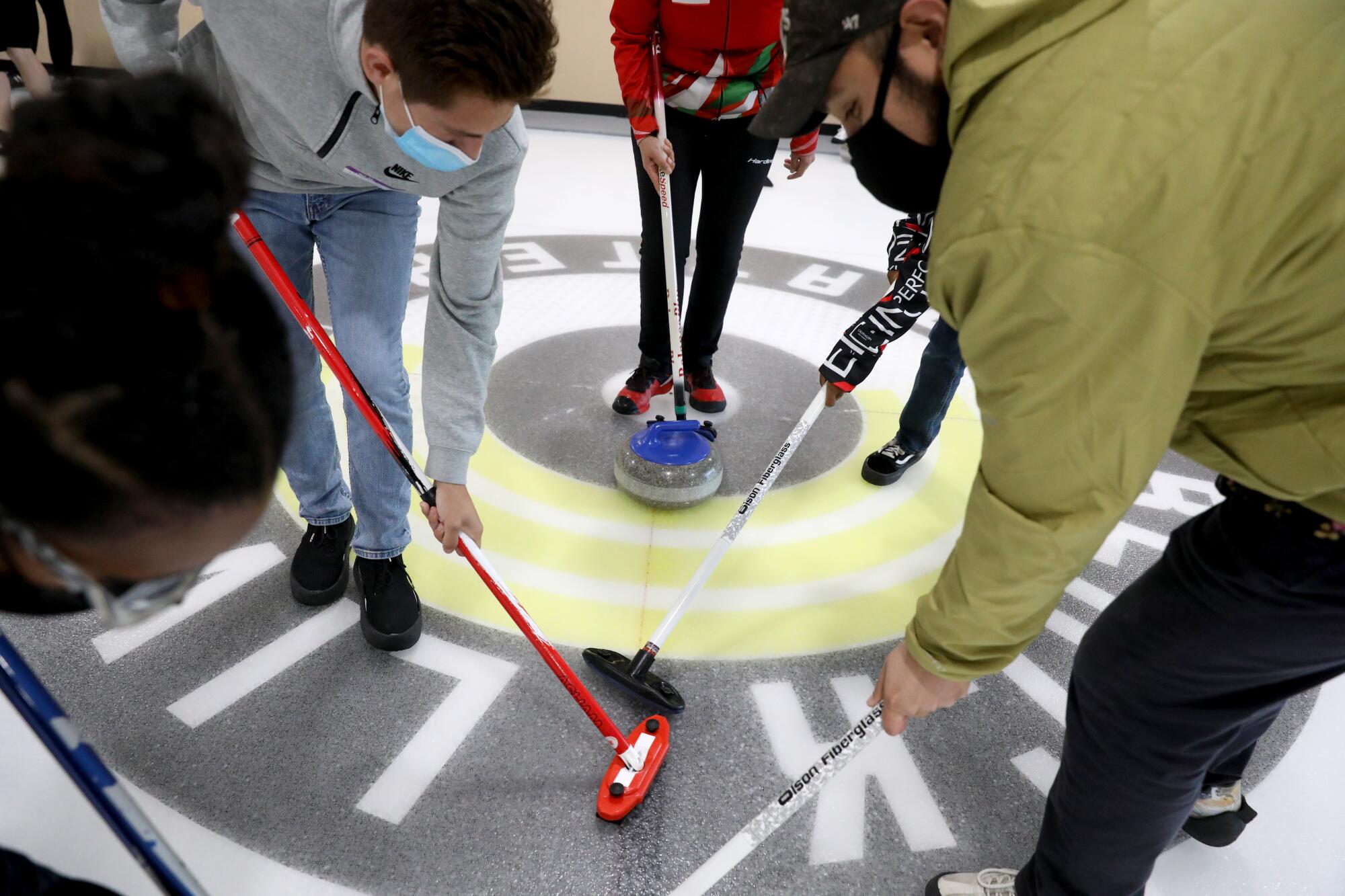
Kristina Lugo, a social media manager from Oakland, has a foot on both sides of that line. Growing up in a Filipina family, Lugo said she never considered trying an ice sport. But after her sister dragged her to a rink for a curling lesson, she felt so welcomed she stayed.
“I love to be able to see a multitude of ethnicities, or backgrounds, sexes, everything,” she said. “It didn’t matter what you were, if you love the sport, you wanted to curl, you just came out.”
Six months later she was competing against a U.S. Olympian and shortly after that she won a bronze medal in her first national event.
“The barrier or the thresholds for what we call competitive curling is much lower compared to other sports,” she said. “What other sport can you say that within your first year you get to play against an Olympian?”
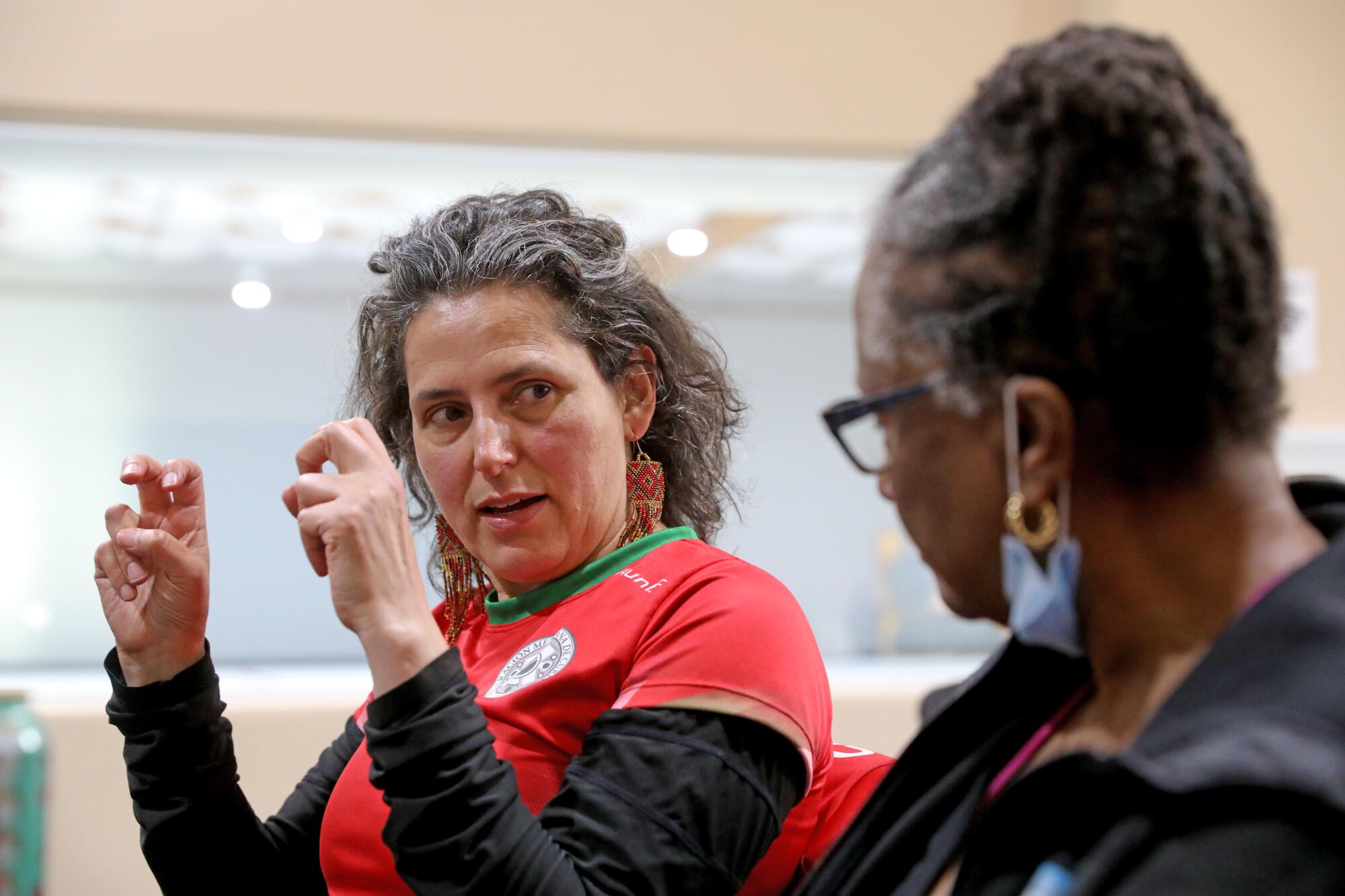
Earlier this year, George and Camarena held a two-day bilingual event at the Southern California Curling Center in Vernon, where they introduced the sport to hundreds of children, many of them Hispanic.
Although Camarena and Jesús Barajas, both of whom have played on Mexican national curling teams, practice at the Oakland facility, the Vernon center is considered the Mexican federation’s base in the U.S. However, Peter Dohm, the center’s co-founder, said he’s more interested in growing the sport than he is in growing Mexican medal-winners.
“Our goal is not to have four Mexican athletes make the Olympics in 2030 or 2034. Our goal is to get 25 active Mexican curlers by the end of the year, 100 curlers by the end of 2023 and 200 by the end of 2024,” he said. “I don’t care if they go nowhere or they go the Olympics.”
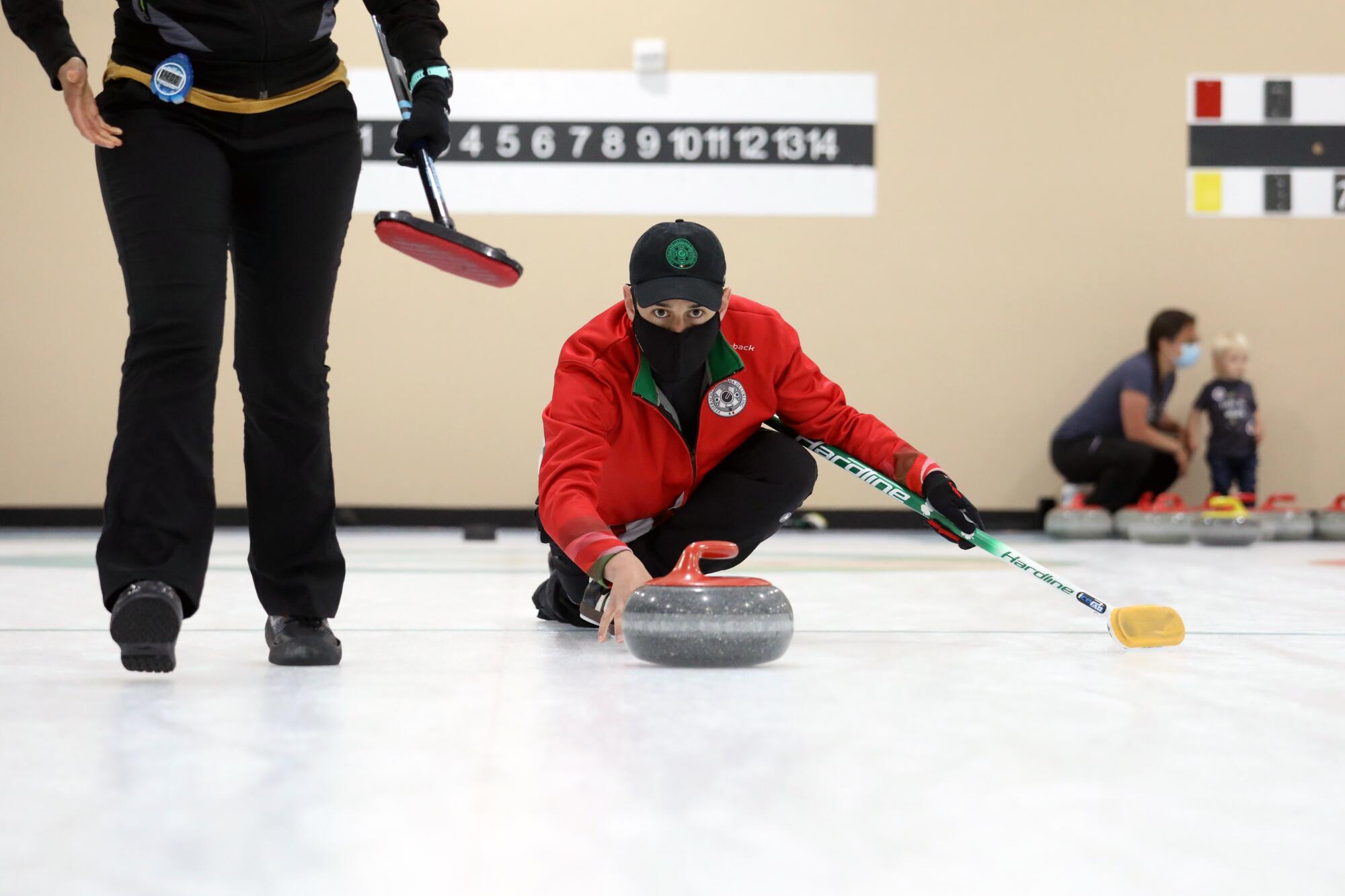
Dohm’s facility has seen an influx of Mexican curlers this summer, among them Veronica Huerta and Karla Martínez, who will join Camarena on Mexico’s team in the 2022 Pan Continental Championship B Division in Calgary in October.
Last year, the 6-year-old Mexican Curling Federation staged its first national championship tournament, although a lack of proper facilities forced the competition to be held in Vancouver. Until a dedicated curling facility is built in Mexico, the growth of Mexican curling will be driven by athletes with access to ice and training outside the country. In Oakland, for example, Camarena and Barajas co-founded the Liga Latina de Curling, a grassroots network of Latinx competitors — many of them Mexican — who practice at facilities across the U.S.
That’s part of a trend that has seen Mexico’s sporting establishment begin to embrace sports such as figuring skating, ice hockey and stock-car racing, that are nontraditional in that country.
The L.A. Kings and other hockey teams see a chance to develop a fan base south of the border, with the hope of playing an NHL game in Mexico before long.
The World Curling Federation, meanwhile, has grown to 68 members, adding Bolivia, the Dominican Republic, Kenya, Kuwait, Turkmenistan and India since 2019. Jamaica, which has just 18 registered curlers, became the third Caribbean nation to join this summer.
Camarena said the addition of mixed doubles, the category she competed in internationally, has also helped the sport grow. It’s quicker pace of play makes it more accessible to the average TV viewer and the smaller team size makes it easier for emerging nations to become competitive. Italy, which had never competed in Olympic curling before, won the gold in mixed doubles earlier this year.
Those are all good trends because the larger and more diverse the sport’s base becomes, Camarena believes, the greater the attention from national federations and sponsors. As proof, she points to a first-of-its-kind training camp she and a team of female athletes will be attending in Winnipeg later this month, sponsored by Asham Curling, a prominent equipment manufacturer.
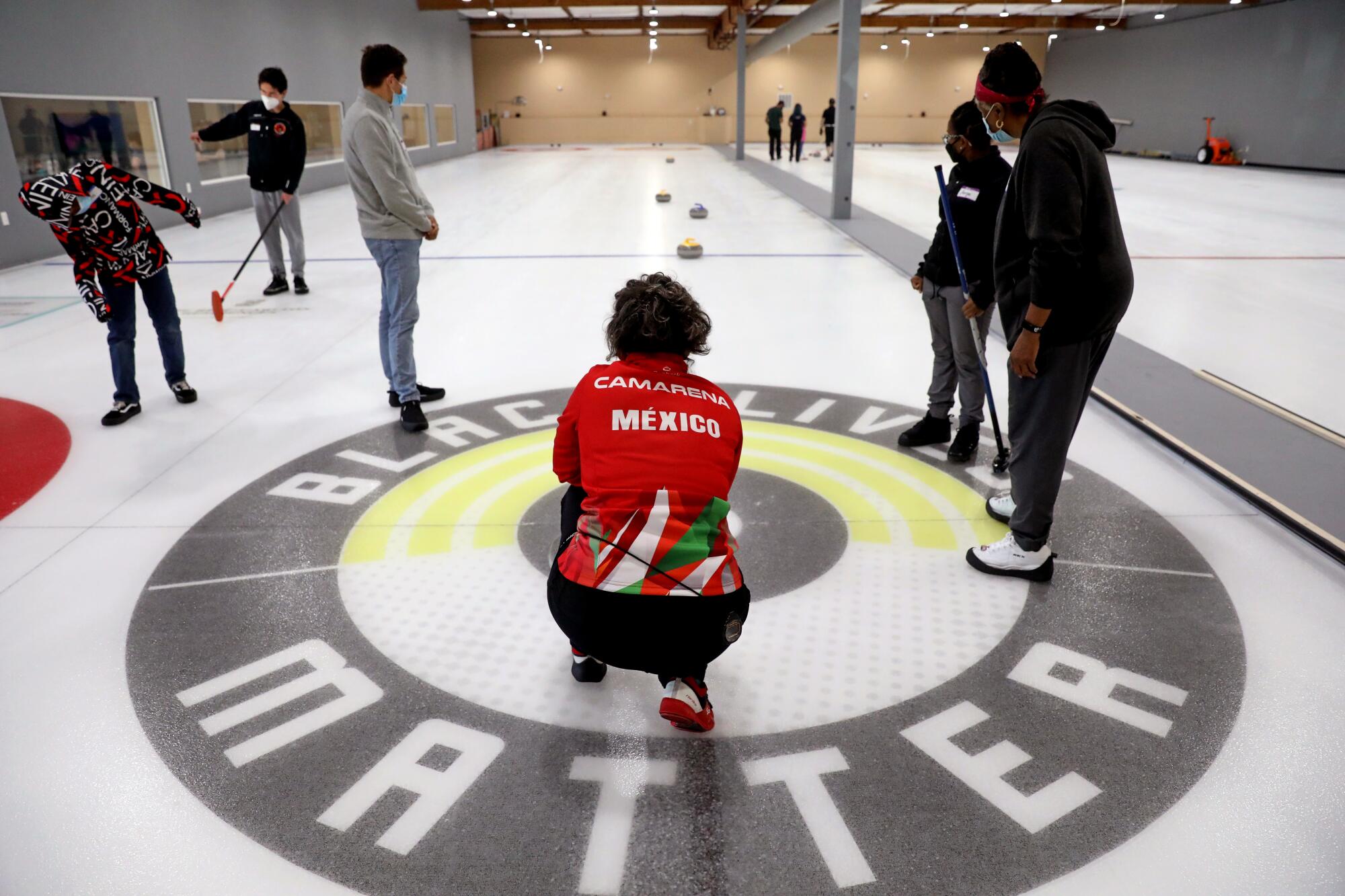
“This is where you start seeing that the pieces of the puzzle are coming together,’ she said. “You have elite athletes willing to support. You have a facility [that] understands the importance of creating diversity in curling but also providing access to the sport to emerging curlers, emerging curling nations.”
The puzzle may finally be coming together for Sepúlveda too. Although he’s ranked as a novice-intermediate-level player, he’s dreaming big again and if he can find a teammate, he hopes to compete in an international tournament in mixed doubles, something he’s not sure any Puerto Rican has ever done.
“I really want to put the Puerto Rican uniform on, represent Puerto Rico,” he said. “We don’t have ice, but we are here. Even in this sport, a winter sport, yes.”
- Share via
Watch L.A. Times Today at 7 p.m. on Spectrum News 1 on Channel 1 or live stream on the Spectrum News App. Palos Verdes Peninsula and Orange County viewers can watch on Cox Systems on channel 99.
More to Read
Go beyond the scoreboard
Get the latest on L.A.'s teams in the daily Sports Report newsletter.
You may occasionally receive promotional content from the Los Angeles Times.

